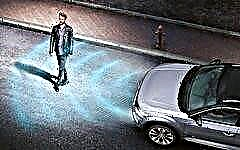

The content of the article:
- History of appearance
- Device and options
- Detection technique
- Principle of operation
- Advantages and disadvantages
- Cars
Pedestrian Detection System is a special auxiliary safety system that detects and avoids collisions with pedestrians. We can say this is a whole mechanism that includes both software and technical part (sensors, cameras, radars). The peculiarity of this system is not only that it can recognize a pedestrian and notify the driver about it, but also drive a car to avoid a collision or minimize its force. As a rule, pedestrian detection is carried out on the carriageway or shoulder, as well as in places that fall within the vehicle's movement area.
How pedestrian detection came about

Since the beginning of the 90s, military engineers have been developing a system for detecting people at a certain distance and territory. Then it was necessary for safety and additional protection, but, like any technology, over time it migrated to civilian use. For the first time, this technology appeared in special cameras that were able to recognize a human face (cameras from Japanese manufacturers of the early 21st century).
Starting in 2010, the car manufacturer Volvo began installing this mechanism on its top-end cars, giving the name to the PDS (Pedestrian Detection System) system - a pedestrian detection system. Today there are several similar systems from different manufacturers, but meanwhile they all work according to the same principle and with the same purpose.
As already mentioned, the main purpose of the pedestrian detection system is to recognize moving objects and notify the driver about it. If we consider the most modern developments of engineers, more precisely the latest versions of this mechanism, then the system can also avoid a collision, control the steering wheel, brake, or even calculate the optimal route to avoid an accident. According to statistics and various studies, after the start of using this system, the percentage of fatal collisions with pedestrians decreased by 20%, and the percentage of serious injuries by 30%, which immediately shows the useful factors of this mechanism.
PDR system design and variants

The design of a pedestrian detection system is a very complex mechanism. As already mentioned, his list includes software and hardware, which are closely interconnected. Depending on the car manufacturer, the technical part of the system may differ, but the software differs only slightly. As a rule, a camera, radar and motion sensors are used in the standard list of pedestrian detection systems, Subaru added another camera (in total, two cameras are obtained in front).
It is not excluded that the pedestrian detection system can parasitize at the expense of other security systems or use separate units. For example, an all-round camera, sensors of various security systems. It should be understood that these are the main details and depending on the make and model of the car, the configuration and structure may change.
How images of pedestrians are recognized

The heart of the pedestrian detection system is software, it is software that recognizes, makes the final decision and issues a notification to the driver. Several methods are used for recognition, each of which is applied under certain conditions. In total, experts identify 4 main methods that are suitable for different situations and work as efficiently as possible, in addition, the cumulative result of such methods gives a large percentage of recognition and detection of pedestrians.
The first and foremost method is holistic detection. In this case, the system is aimed at detecting an integral moving object. Integral dimensions are recognized, the control unit analyzes the obtained dimensions and compares them with similar dimensions, and the infrared sensor indicates the presence of heat in the recognized object, the system makes the appropriate conclusion that this object is a person (at least a living object).

The second method for detecting pedestrians is the partial method. In the image obtained from the camera, not the complete image is considered, but only individual elements or their combination. As a rule, these can be the contours of the head, torso, limbs, or their combination. For this method, the dimensions of individual contours and parts are also saved in the database. The method is an order of magnitude more accurate than the previous one, but it takes more time to collect and analyze information.
The third method is pedestrian detection by patterns. Rather, it is not even a separate method, but a combination of the two previous ones (integral and partial). The control unit is equipped with a special large database, which contains fixed information about the shape of the body, individual body parts, possible deviations from the standard and other characteristics of pedestrians.
The fourth method for detecting pedestrians is through the use of multiple cameras. This method is most often used in Subaru cars, as a result of which each camera can track a specific pedestrian, and the system, in turn, predicts the trajectory of each pedestrian. Thanks to this method, the safety of the car is much higher, in addition, the system can analyze many more situations in order to avoid a collision with a pedestrian. The control unit divides the overall picture into several separate fragments, each of which is analyzed separately for possible collision risk.
How Pedestrian Detection Works

The most effective distance for detecting a pedestrian is 40 meters, but much depends on weather conditions, terrain and lighting. As soon as the system detects the pedestrian, the analysis of the direction of movement of the object and the subsequent location at the moment of the closest approach of the car to the pedestrian is carried out. Often, such a system displays an image on the display of the multimedia system so that the driver can understand the situation on the road as much as possible and take subsequent actions. In parallel with the display of the image on the display, the pedestrian detection system analyzes the probability of a collision. If the probability is negligible or completely absent, the driver is simply shown the image of a pedestrian without any additional signals. In the event that the system has determined that a collision is imminent in the current state of the vehicle, a corresponding sound signal is sent to the driver.

Modern pedestrian detection systems, especially from Volvo, have received improvements in the direction of intelligence. If a collision is imminent after detecting a pedestrian and the driver takes no action, the system takes over and tries to avoid the collision as much as possible. As a rule, this is control of the steering wheel, braking system and the engine in general.
The system also takes into account and recognizes moving vehicles and other objects, thereby leading to a minimal collision scenario, or minimizing the consequences. In this case, the system uses the emergency braking mechanism and activates other safety systems installed on the vehicle.

According to statistics from various tests, the pedestrian detection system can independently avoid a collision at speeds up to 35 km / h, although at the beginning of 2019 they talk about raising the bar to 50 km / h. By exceeding this speed threshold, the system cannot completely avoid a collision on its own, but can minimize the consequences and severity of striking a pedestrian. Thus, today the statistics of a collision with a pedestrian and serious consequences at a speed of 65 km / h is 85%, at a speed of 50 km / h the indicator is 45%, and at 30 km / h only 5%.
Volvo engineers have reduced the risk of injury to pedestrians by sharing other safety systems such as pedestrian airbags (between the windshield and the hood of the car) and pedestrian protection systems. If we talk about the most modern mechanisms for detecting pedestrians, then they are based on a night vision system, which allows you to work at night and get more accurate analysis results. On the other hand, the analysis of active collision avoidance in such a system works much worse.
Advantages and disadvantages of the PDR system

Any mechanism, no matter how perfect it is, has its pros and cons. The pedestrian detection system also has advantages and disadvantages. If we talk about the advantages, then here it is a significant help to the driver, avoiding possible accidents. An important factor is the logic of the control unit, when it can apply the solution on its own and, if necessary, completely stop the car or reduce injuries to a minimum. Best of all, the pedestrian detection system has shown itself in the mode of urban movement, when a child can run out from behind a car or a pedestrian can get out onto the roadway.
As for the negative aspects, despite the complexity of the system and the loud name, they also exist. For example, a holistic pedestrian detection method can generate an error when several pedestrians or different objects (living and non-living) enter the recognition zone at once. As a result, the system will not be able to draw conclusions correctly.
Another huge factor and also a minus is weather conditions. The system practically refuses to work in rainy weather and does not work at all in snowy weather. The recognition result will be much worse in fog or in poor lighting conditions. In addition, it should be understood that the last decision still remains with the driver, as well as the consequences of a collision with a pedestrian, so this system is rather auxiliary for the driver and only in the most urgent and unpredictable situations can make a final decision without the right to interfere. If necessary, the system can be turned off, since in populated cities and heavy pedestrian traffic, the system simply will not allow the car to move.
Which cars have the PDR system installed

Volvo is considered to be the very first and main car manufacturer, on which cars the pedestrian detection system can be most often found. They were the first to develop and begin to install such a mechanism. Today, pattern recognition has been perfected and, observing all the rules and speed, the probability of avoiding a collision is more than 90%. An example of this is the Volvo S90 sedan or the Volvo XC90 crossover.
Subaru has not lagged behind developments, having developed a method for detecting pedestrians through the use of two cameras in front of the car. Most often, such a mechanism can be found on the Subaru Legacy and Outback models. A similar system can also be found on top models of cars from Mercedes-Benz, Audi, BMW, Rolls-Royce, Land Rover and other well-known brands. Many countries have adopted an agreement that such premium cars, starting from the basic configuration, must be equipped with a similar mechanism.
It is clear that the presence of a pedestrian detection system on board the car adds a certain amount to the total cost. On the other hand, if it is possible to install a pedestrian detection system on a car at the time of purchase, you should not save on this, since in the future it can play more than one positive role in different situations.











